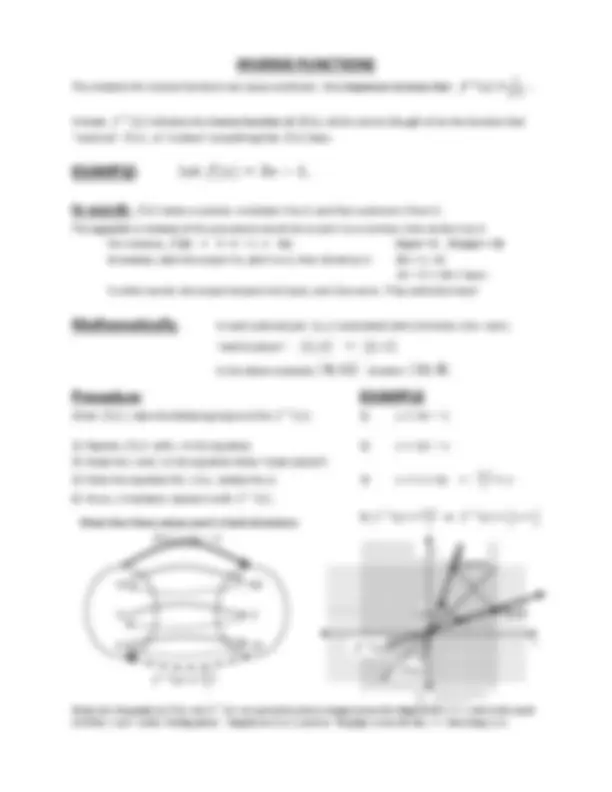



Study with the several resources on Docsity

Earn points by helping other students or get them with a premium plan


Prepare for your exams
Study with the several resources on Docsity

Earn points to download
Earn points by helping other students or get them with a premium plan
Community
Ask the community for help and clear up your study doubts
Discover the best universities in your country according to Docsity users
Free resources
Download our free guides on studying techniques, anxiety management strategies, and thesis advice from Docsity tutors
The concept of function composition and inverse functions using the example of a quadratic function. It covers the basics of function notation, the process of composing functions, and the significance of inverse functions. The document also includes examples and visualizations to help clarify the concepts.
What you will learn
Typology: Lecture notes
1 / 2

This page cannot be seen from the preview
Don't miss anything!


Imperial Valley College
Math Lab
In order to perform a composition of functions, it is essential to be familiar with function notation.
If you see something of the form “𝑓
= [expression in terms of x ]”, this means that whatever you see
in the parentheses following f should be substituted for x in the expression. This can include
numbers, variables, other expressions, and even other functions.
2
2
2
2
3
3
2
3
2
Etc.
A composition of functions occurs when one function is “plugged into” another function.
The notation (𝑓 ○𝑔)(𝑥) is pronounced “𝑓 of 𝑔 of 𝑥”, and it literally means 𝑓
In other words, you “plug” the 𝑔(𝑥) function into the 𝑓(𝑥) function.
Similarly, (𝑔 ○𝑓)(𝑥) is pronounced “𝑔 of 𝑓 of 𝑥”, and it literally means 𝑔(𝑓(𝑥)).
In other words, you “plug” the 𝑓(𝑥) function into the 𝑔(𝑥) function.
WARNING : Be careful not to confuse (𝑓 ○𝑔)(𝑥) with (𝑓 ∙ 𝑔)(𝑥), which means 𝑓(𝑥) ∙ 𝑔(𝑥).
2
a. (𝑓 ○𝑔)(𝑥) = 𝑓(𝑔(𝑥)) = 4 [𝑔(𝑥)]
2
2
2
b. (𝑔 ○𝑓)(𝑥) = 𝑔(𝑓(𝑥)) = 2 ∙ 𝑓(𝑥) + 1 = 2 ( 4 𝑥
2
2
A function can even be “composed” with itself:
c. (𝑔 ○𝑔)
INVERSE FUNCTIONS
The notation for inverse functions can cause confusion. It is important to know that 𝒇
−𝟏
𝟏
𝒇(𝒙)
Instead, 𝑓
− 1
(𝑥) indicates the inverse function of 𝒇(𝒙), which can be thought of as the function that
“reverses” 𝑓(𝑥) , or “undoes” everything that 𝑓(𝑥) does.
EXAMPLE : Let 𝑓(𝑥) = 3 𝑥 − 1.
In words , 𝑓(𝑥) takes a number, multiplies it by 3 , and then subtracts 1 from it.
The opposite or reverse of this procedure would be to add 1 to a number, then divide it by 3.
For instance, 𝑓(𝟒) = 3 ∙ 4 − 1 = 𝟏𝟏. Input = 4 , Output = 11
In reverse , take the output 11, add 1 to it, then divide by 3: 11 + 1 = 12
12 ÷ 3 = 𝟒 = input.
In other words, the output became the input, and vice-versa. They switched roles!
Mathematically , In each ordered pair (𝑥, 𝑦) associated with a function, the x and y
In the above example,
became
Procedure : EXAMPLE :
Given 𝑓(𝑥) , take the following steps to find 𝑓
− 1
Replace 𝑓(𝑥) with y in the equation 2) 𝑥 = 3 𝑦 − 1
Swap the x and y in the equation (they “trade places”)
Solve the equation for y (i.e., isolate the y ) 3) 𝑥 + 1 = 3 𝑦 →
𝑥+ 1
3
− 1
− 1
𝑥+ 1
3
or 𝑓
− 1
1
3
1
3
y
x
− 1
𝑥+ 1
3
Notice how the graphs of 𝒇(𝒙) and 𝒇
−𝟏
(𝒙) are symmetric (mirror images) across the diagonal line y = x , which is the result
of all the x - and y - values “trading places”. Imagine each (𝑥, 𝑦) point as “hopping” across the line y = x , becoming (𝑦, 𝑥).
− 1
Check that these values work in both directions:
− 1
𝑥+ 1
3